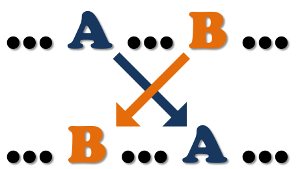Methods Used To Find Symbolic Definitions
In order to understand Symbolic words, they need to be defined. As you discovered on the previous page the word Bread is defined as “the word of God” or the “Bible“. Definitions help you to make sense out of texts with symbolic meaning. The definitions are used to help you paraphrase the original Bible text to give the text a new alternative meaning that God has buried in the text. The reason I am explaining these methods of finding symbolic definitions in detail is not so that you will memorize them, or be overwhelmed by them, but to show you how they work, and what the variations on each one is. It may seem overwhelming as you read through these methods at first, but don’t worry about the details just understand that they exist and how they work. This will help you when looking for the definitions of the symbolic word. You can always refer back to this page to see the details when and if you need them.
Looking for Symbolic Key Words to Identify Definitions:
What to Look For:
- Symbols are most often Nouns. Names of Objects. Animals, tools, Places, and other things or objects, but,
- Sometimes Symbols can be adjectives like a color.
- Sometimes Symbols can be a Phrase like “Apple of His Eye”.
Equal to, or Equivalency:
Scan the Concordance or Computer Search for information about your Symbol of interest, among other things, noticing texts that use words like, “is”. The word “is” is a clue. It means “equal to”. Remember in school when they taught you to do word problems in math? The word “is” meant “equal to” ( = ). That’s the way it is in the Bible also. When I see the word “is” I look for a possible definition to follow.
Other Equivalent terms:
- “Is” means “equal to”.
- Other Words to Watch also for: “are“, and “Even As“, or “Even“, and “Like Unto“, “is Like“, or “shall be“
- “These are” 2 Peter 2:1, 17. (see BMS vol. 2 page 40)
Inductive Reasoning
Inductive reasoning is the last resort method and should be used sparingly because the definitions are most often found plainly somewhere in the Bible.
- Use all the facts to prove the meaning. A general conclusion based on the agreement of all the facts of the texts.
- Inductive reasoning can bring you to a conclusion but remember it is the Bible that should supply the actual meaning. The facts of the texts are what will actually supply the meaning.
Parallelism
Don’t pass this method by lightly, Parallelism is one of the main methods used to find Symbolic definitions. Parallelism is a technique of redundancy, to enforce the meaning of the text. By repeating something the message stresses. When repeating the message the author will use words that have similar meaning but different words to get their idea across. Usually, the most important part of the message will be stressed with parallelism. Even in modern language parallelism is used to help us to help us express a word.
What to Look For:
• Watch for a text where an idea is repeated using different words. Psalm 119:130; Daniel 9:16.
Correlative Terms.
The didactic (teaching, or intending to teach, a moral lesson) methodology of Proverbs is displayed by its frequent use of words that are found together either as synonyms or antonyms. These are sometimes referred to as fixed pairs or Word Pairs. “Wisdom” (חָכְמָה, chokhmah) is often paired with “understanding” (תְּבוּנָה, tevunah) or similar ideas (e.g., “knowledge” [דַּ֫עַת, da’ath] or “discipline” [מוּסָר, musar]). Other words that are frequently found together are “fool” (כְּסִיל, kesil), “simple ones” (פֶּ֫תִי, pethiy), and “scoffers” (לֵץ, lets). This parallelism reinforces an action or attitude. – BRICKER, D. P., “Proverbs, Book of, Critical Issues”, The Lexham Bible Dictionary.
Parallelism is a wide topic and can get complicated, but what is necessary is to know its role in the Bible. It is used widely to emphasize a thought or action by repeating a word, or a similar word the second time. When looking for the meanings of symbols it is helpful to recognize that when you see something repeated in other terms you should pay attention to see if one line is defining the Symbol in another line. Below I have listed the main forms of parallelism so that you will be aware of it. You may study it to your benefit.
Parallelism—Is an element of Hebrew poetry that places similar ideas side-by-side for emphasis. By mentioning Sodom, a Bible may refer to the city of Sodom, but mentioning Gomorrah in parallel to Sodom infers wickedness and moral corruption. Jeremiah 23:14
In Old Testament poetry, the Bible often uses two different words in parallel to bring attention to the word being described. (Hos Jeremiah 5:8; Psalms 98:6).
- Often the second line of the parallel couplet (Word Pair) does not merely restate the first line but builds on it (i.e. “A, and what is more, B”) .
- Parallelism can be seen in the Synoptic Gospels, saying the same thing with different words. Reinforcing and supporting what the other Gospels said.
- Parallelism reinforces an action or attitude.
Forms of Parallelism:
Here is where it gets a bit complicated. The important thing to know is that these forms exist and how they work. This will serve to help you recognize Symbolic definitions. I have tried to break it down as simply as I can. The bold text after the bullet point are the formal label for the method, the words in the parenthesis are the common use label of the method.
- Synonymous Parallelism, (Repeating Parallelism) meaning that the two phrases of the verse basically state the same thing, Same thought repeated in different terms. Psalm 13:1; Psalm 24:1; Job 38:28
- Antithetic Parallelism, (Contrasting Parallelism) presents two lines in contrast to one another. Parallel statements are placed opposition to one another. Proverbs 10:27-28; Psalm 1:6; 2 Peter 2:1, 17
- Complete Parallelism (antithetic), When a poet uses complete parallelism, he repeats the exact idea or the opposite idea of the first line in the next line.
- Climactic Parallelism, (Staircase, or Progressive Parallelism), one of the most interesting forms of parallelism was “staircase” or climactic parallelism.
- Synthetic Parallelisms, (Complimentary Parallelism)—formations in which a series of cola (lines) are composed of generally separate but complementary ideas.
In some cases, the synthetic relationship can be described as an intensification of the first statement. Ps 100:3; Prov 15:3; Ps 1:1 - Incomplete Parallelism, If the Hebrew poet used incomplete parallelism, he would not repeat the entire idea of his first line in the second line of his poem.
- Chiastic Parallelism, clearly avoids expressing the same idea (thoughts) twice. It rather aims at a sequence of thought which brings out the essence of the point more fully and sharply.
- 3 Chiastic Patterns – ABBA (our letter”X” in Greek is chi)
* Chiastic Parallelism, clearly avoids expressing the same idea (thoughts) twice. It rather aims at a sequence of thought which brings out the essence of the point more fully and sharply
GUGLIOTTO
, L. J., Handbook for Bible study: a guide to understanding, teaching, and preaching the word of God (Hagerstown, MD 2000). see Figure 11
* 3 Chiastic Patterns – ABBA (chi, the letter X in Greek)

Chaism Illustration
- Simple Chiasm (Isa 11:13)
- Line Chiasm (Prov 23:15-16)
- Stanza Chiasm (Job 26:12-13)
- But many that are first shall be last;
and the last shall be first. Matthew 19:30 - And whosoever shall exalt himself shall be abased;
and he that shall humble himself shall be exalted. Matthew 23:12
As an example, Some extra-Biblical Chiasms are:
Ask not what your country can do for you
— ask what you can do for your country JFK
Let us never negotiate out of fear.
But let us never fear to negotiate. JFK
Let us preach what we practice —
let us practice what we preach. Winston Churchill
The primary purpose of parallelism may be aesthetic: it is appealing and memorable. Beyond this, it creates emphasis.
In some instances, parallelism is used in a climactic or “Staircase” way, piling up synonymous expressions one upon another until finally the significant declaration is made.
Catagories: Eight categories of parallelism:
1. Gender-matched
2. Word-pairs
3. Number
4. Staircase
5. Synonymous-sequential
6. Noun-verb
7. Vertical
BODENHAMER, K. W., “Poetry, Biblical”, The Lexham Bible Dictionary,
the primary purpose of parallelism may be aesthetic: it is appealing and memorable. Beyond this, it creates emphasis.
POWELL, M. A., “parallelism”, The HarperCollins Bible Dictionary (Revised and Updated), 740.
In some instances, parallelism is used in a climactic or “Staircase” way, piling up synonymous expressions one upon another until finally the significant declaration is made:
POWELL, M. A., “parallelism”, The HarperCollins Bible Dictionary (Revised and Updated), 740.
parallelism—an element of Hebrew poetry that places similar ideas side-by-side for emphasis. By mentioning Sodom, a biblical author may simply refer to the historical city, but mentioning Gomorrah parallel to Sodom highlights a portrait of extreme and utter wickedness. GARRETT, J. K., “Gomorrah”, The Lexham Bible Dictionary.
In Hebrew poetry, writers often used two different words in parallelism to bring attention to the item being described. Occasionally, the words הֲצֹצְרָה (hatsotserah) and שׁוֹפָר (shophar) are used together in this manner (Hos 5:8; Ps 98:6). Garrett, J. K., “Horn”, The Lexham Bible Dictionary.
Parallelism by pointing out that often the second line of the couplet does not merely restate the first line but builds on it (i.e. “A, and what is more, B”) MELVIN, D. P., “Jeremiah, Book of”, The Lexham Bible Dictionary.
Parallelism between the Synoptic Gospels – Parallelism can be seen in the Synoptic Gospels, saying the same thing with different words.
Parallelism reinforces an action or attitude.
BRICKER, D. P., “Proverbs, Book of, Critical Issues”, The Lexham Bible Dictionary.
Well (With Water) = Teacher of Truth
Salt = God’s People, God’s Law (Covenant)
Rubies = Wisdom
Reed (Broken) = Egypt – Trusting in Man






